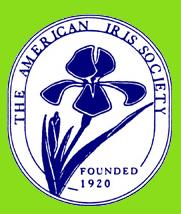
to the
Greater St. Louis Iris Society!
(Organized circa 1950)
How to Plant and Grow Beardless Iris
Beardless irises will be a beautiful asset to your garden if you meet their cultural requirements. Upon arrival from a private or commercial source, the plants will have been wrapped in damp paper and plastic bags. Immediately remove the rhizomes and soak the roots overnight in water. This will allow the plant to replenish the water lost in transit and get the plant off to a good start in your garden. Do not let the roots dry out during transplanting.
WHEN TO PLANT
Beardless irises may be planted in August, September and October depending on your climate. The fall usually brings rain to supplement watering and roots will grow well as the weather cools. The new root growth is needed to anchor the plants before winter. Plant your iris at least four weeks before your first hard freeze or killing frost.
WHERE TO PLANT
Most beardless irises need a sunny location for best performance and bloom. If plants get less than a half-day of sun they may not bloom well. Siberian irises like even moisture while Japanese irises like as much water as you can provide. These types do not, however, like to have wet feet in the winter time. Louisiana irises and several of the beardless species will grow in standing water year round in the south. Spuria irises require dry conditions during their summer dormancy in July and August.
GARDEN SOIL
Your beardless irises will thrive in a good garden loam with added organic matter such as humus or compost. An acid soil is preferred, but Japanese irises are the only beardless irises that require an acid soil. A pH of 5.0 to 6.5 is needed for optimum Japanese iris performance.
HOW TO PLANT
Plant Louisiana, Spuria and Siberian irises about one inch deep. Japanese should be planted a little deeper, about two inches, as they make new roots on top of old roots. Keep newly planted rhizomes well watered until they show active new growth. Drying out at this stage will result in almost certain plant death. Once established, beardless irises grow well, but extra care is needed to start them out. After plants are showing new growth, add a mulch of two to three inches (except on Spurias) and leave it on year round. This retards weeds and allows the roots to remain cooler. Also it prevents sun scalding to Louisiana rhizomes.
FERTILIZATION
The soil type for your area will determine your fertilizer needs. For optimum growth an application of a balanced fertilizer in the spring is recommended when the plants are a few inches high. Japanese are especially heavy feeders and appreciate a second feeding before bloom time.
GENERAL GARDEN CARE
It is important to keep your iris beds free of weeds for optimum growth. After bloom is finished, cut off the bloom stalks before any seedpods made by bees develop as seeds from these would contaminate your named cultivars. Beardless irises can grow for several years in the same location if fed on a regular basis. Japanese irises are the exception - they must be divided every three years to thrive. After fall frost, clip off brown foliage to discourage rodents from nesting in the clump. Louisania foliage in southern climates will remain green and should not be cut off.
© 2011 - Greater St. Louis Iris Society

